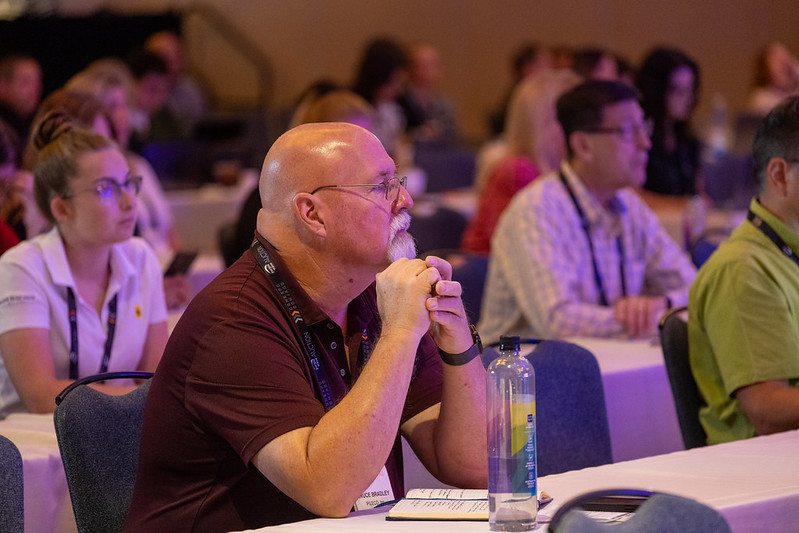By Jaime Vos, Director, AEM Safety Materials Program —
“That’s the goofiest idea I’ve ever heard!”
I sat in stunned silence, the comment crushing me to the core. I had given serious thought about my creative solution and was excited to share it with my co-workers, only to hear the team leader rip it apart in front of everyone.
Demoralized, I remained quiet for the rest of the meeting.
Thankfully, I didn’t work for that company very long, but the lesson stayed with me: Sharing new ideas is difficult. It requires vulnerability, courage and, most importantly, trust among your peers. If your work culture isn’t supportive and respectful of everyone’s ideas (no matter how outrageous they may sound), your organization won’t create anything new.
Fast forward to today: Innovation is at the top of every organization’s goals. The word is infused within mission statements, business plans and revenue strategies. Innovating your products and services is critical to survive in a world that changes rapidly, not only with technological advances, but also with the way people work. Companies have been forced to think differently about their business models, their processes and their workspaces. Most importantly, they’ve had to examine how their employees collectively ideate to grow the organization.
It’s almost cliché now to use the phrase, “think outside the box.” Of course, it’s an easy one to understand on the surface, but what are the actual steps needed to do it? While there are numerous books and theories about how organizations can think differently, I’ve found the following to be the most important areas for companies to focus on to establish a baseline for cultural innovation.
1. Build a foundation of trust.
Before anyone can collaborate creatively toward innovative thinking, they must be willing to trust each other. Employees (and their leaders) must set aside their egos and understand that everyone is working toward the same goals. It’s not about what I want or what you like, it’s about what’s best for the organization as a whole. Employees must feel empowered to express their ideas, concerns and constructive criticism without judgment or retaliation. Once a culture has established an environment of trust, they understand they are dependent on each other for success. Only then can ideas truly begin to flow.
2. Cultivate creative collaboration
Once employees feel they are part of a trusted team, they are empowered to think differently in a way that moves the organization forward. Creative collaboration strengthens the bonds of trust and builds momentum needed for critical thinking. For this reason, it’s important that senior leadership constantly inspire employees to share ideas at all times. When a team feels recognized and respected, they naturally create space for ideation to flourish.
3. Encourage experimentation.
It’s rare that ideas appear out of nowhere. They are often the result of joining two disparate thoughts together to form one new idea. AEM Product Safety & Compliance Seminar keynote speaker Jeremy Utley said it best: Our brains take pieces of info that we already know. It like playing with Legos, you’re putting two things together and when they snap together- that is what an idea is, the convergence of two pieces of information.” In grade school, we’re conditioned to raise our hand only if we have the ONE right answer. But an effective innovation process requires trying many different approaches and testing theories, with the possibility of finding multiple solutions.
4. Have the courage to fail.
To that point, when experimentation is encouraged, failure is certain to follow. Leaders need to emphasize that this is acceptable if risks are managed and minimized. The biggest mistake creative teams often make is expecting success on the first try. Using the Legos example, ideas may need to be sorted, arranged, put together, pulled apart and rearranged many times before the best solution can be determined. During that process, it’s expected that most of the initial results won’t be favorable. It’s also important to keep failure in perspective. When a reporter asked Thomas Edison, "How did it feel to fail 1,000 times?" Edison replied, "I didn't fail 1,000 times. The light bulb was an invention with 1,000 steps."
5. Make it fun.
Ideation and problem solving don’t have to be so serious. Many of us played a wide variety of board games and video games as children. Winning the game was always the end goal, but the process and strategies of how to win were very different in each case. The journey to winning any game requires problem solving, strategy, predictive analysis and risk. But that’s what makes the experience fun. It’s no different initiating cultural innovation within any organization. People are naturally curious and enjoy winning. As long as leadership supports all of the previous areas of focus, employees will naturally engage with each other in creative ways toward an end goal.
The Bottom Line
Cultural innovation has many benefits. Not only can it generate new ideas for additional revenue, but it can create new efficiencies in time and resources. It also empowers employees to give their all, to feel recognized and foster stronger working relationships (which create stronger momentum toward growth and collaboration).
And finally, it’s important to acknowledge that a company’s greatest asset is its employees. An organization’s products and services don’t build, ship or service themselves. Employees do that. And in order for that organization to grow those products and services, it must innovate using the workforce most familiar with its business model.
In the many years since my “goofy idea” got rejected, I’m proud to say that I’ve come up with many more. For some of them, the timing wasn’t right. For others, they needed to be joined with someone else’s goofy idea in order to be a viable solution. In every case, I always collaborated with other creatives I trusted and, in turn, have always empowered others to share their ideas.
The need to innovate will never go away. It’s imperative that leaders inspire and empower their workforce to bring ideas forward. The next time an employee shares a goofy idea, just consider it may be the groundbreaking solution that moves your organization into the future.
Subscribe to the AEM Industry Advisor for more perspectives from AEM staff.





